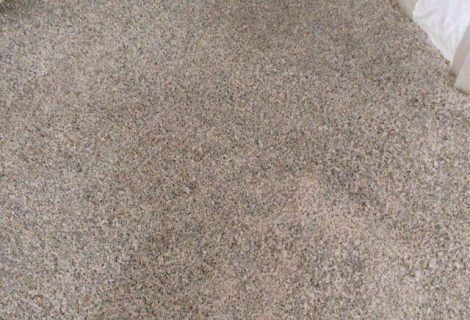CONTROLLED CRACK INDUCER PIPES
CRACK INDUCER PIPES
Singular continued concreting of reinforced concrete walls and walls of water tanks at long sections, however, requires certain knowledge of the properties of concrete and later rheologic influence on the behaviour of the entire structure.
In terms of structure tightness, however, very important are additional concrete deformations that take place during the use of the structure, occurring due to concrete contraction and creep. In order to limit the emergence of uncontrolled fractures and the costly and time-consuming repair work occurring because of this, controlled crack inducer pipes should be used. Their two-stage behaviour weakens, in a controlled manner, the wall cross-section, causing vertical cracks along the weakening profile, and ensures tightness by virtue of sealing anchors.
GENERAL INFORMATION
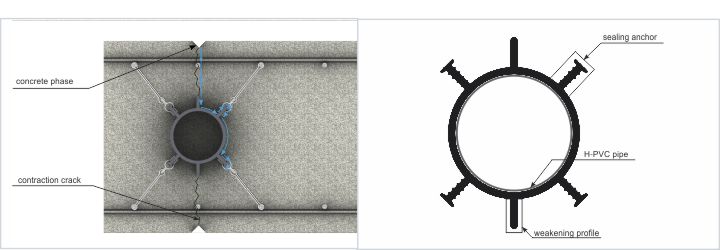
General information
Singular continued concreting of reinforced concrete walls and walls of water tanks at long sections, however, requires certain knowledge of the properties of concrete and later rheologic influence on the behaviour of the entire structure. In terms of structure tightness, however, very important are additional concrete deformations that take place during the use of the structure, occurring due to concrete contraction and creep.
By virtue of complexity of rheologic effects and complicated mathematical procedures, as well as numerous assumptions of the threshold state to be made during the calculation of these parameters, they are often neglected in terms of strength calculations for structures. In such cases, the designer’s role is often limited to including maximum expansion joint spacings in the design, indicating the minimum reinforcement field and the guidelines to be fulfilled with respect to concrete layout and care.
Engineering practice shows, however, that such means are not always sufficient. The result is wearing of shields. The difficulty of achieving good seals, and sometimes of indicating of the proper leak spots, the emerged cracks, may reduce the usability of a structure and greatly increase its usage costs. From the practical standpoint, the following is worth quoting:
‘Prevention is better than cure’ with respect to repair of cracked shields. Seeking to limit uncontrolled reinforced concrete wall fractures, one available solution is weakening of the wall cross-section through creation of precisely positioned vertical cracks. The use of Besaflex type S induced crack piping additionally protects the created crack from penetration by pressing water using the labyrinth effect.
| Properties | Unit |
Requirements | Tested per |
| External form | – | No cracks, rifts | Visual evaluation |
| Shore hardness | ˚Sh | 83±5 | PN-EN ISO 868:2005 |
| Stretch resistance | MPa | ≥ 9 | PN-EN ISO 527-2:1998 |
| Relative elongation at break | % | ≥ 200 | PN-EN ISO 527-2:1998 |
| Shear resistance | N/mm | ≥ 8 | PN- ISO 34-1:2007 |
| Low temperature behaviour, -20 ˚C, relative elongation at break |
% | ≥100 | PN-EN ISO 527-2:1998 |
| Controlled crack inducer pipe |
||||||||
| Symbol |
a [mm] |
d [mm] |
f [mm] |
Wall width [mm] |
Package [pcs./pallete] |
Sales unit |
Weight [kg/mb] |
Art. no. |
| Type H1 L=3 m | 128 | 88 | 25 | 240÷350 | 100 | pcs. = 3m | 2,80 | SU-TU-RR-0-02357 |
| Type H1 L=4 m | pcs. = 4m | SU-TU-RR-0-02358 | ||||||
| Type H1 L=5 m | pcs. = 5m | SU-TU-RR-0-02359 | ||||||
| Type H2 L=3 m | 235 | 175 | 25 | 350÷500 | 50 | pcs. = 3m | 5,50 | SU-TU-RR-0-02360 |
| Type H2 L=4 m | pcs. = 4m | SU-TU-RR-0-02361 | ||||||
| Type H2 L=5 m | pcs. = 5m | SU-TU-RR-0-02362 | ||||||
| Type H2 L=7 m | pcs. = 7m | SU-TU-RR-0-02363 | ||||||
| Type H3 L=3 m | 110 | 60 | 25 | 170÷240 | 120 | pcs. = 3m | 2,00 | SU-TU-RR-0-02364 |
| Type H3 L=4 m | pcs. = 4m | SU-TU-RR-0-02365 | ||||||
| Type H3 L=5 m | pcs. = 5m | SU-TU-RR-0-02366 | ||||||
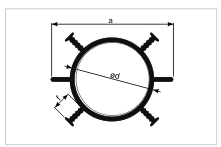
Usage
Hidroplasto controlled induced crack pipes should be used at sites under threat of influence of liquids under hydrostatic pressure or of groundwater, for which the formwork or concreting technology requires the works to be carried out along large wall sections. The induced crack pipe selection depends on the thickness and height of the component to be weakened. No joined pipes should be used, and no piping composed of short sections should be used either. The axial separation of the selected controlled induced crack pipes depends on the following formula:
where:
R – axial pipe spacing,
h – height of component to be weakened,
g – component thickness.
INSTALLATION
The cut should be executed perpendicular to the smooth weakening profile niches, with a length allowing embedding of the pipe on a band at a height of 5 cm above the slab face. The induced crack pipe and the external reinforcement arrangement are best trimmed to size directly at the construction site. All works related to the placement of the pipe at the target location are best done before execution of the horizontal wall reinforcement bars and arrangement of the formwork hindering access and the installation specialist’s range of motion.
The controlled induced crack pipe should be embedded in a stable manner on the internal day joint band or the sealing sheet steel. At the same time, sealing anchors should be tied to the wall beginning bars using installation grips and tie wire, utilising at least 8 pcs./running metre.
During concreting works, make sure that the height of the laid out concrete mix is equal on both sides of the pipe. After the pipes are concreted up to the desired height, the interiors of the induced crack pipes must also be filled. The pipe placed for rigidity must not be removed.
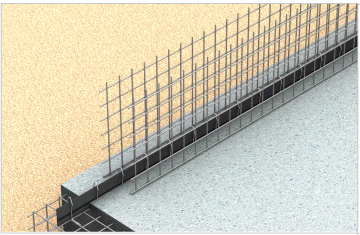 |
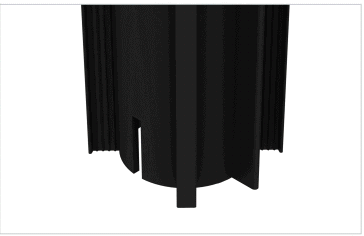 |
| Step 1. Concreting of the sealing band at the slab-wall intersection | Step 2. Cutting of the pipe underside and trimming to size. |
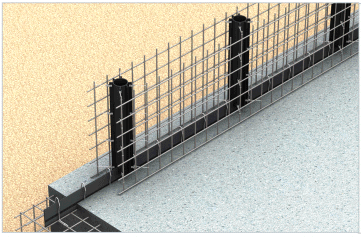 |
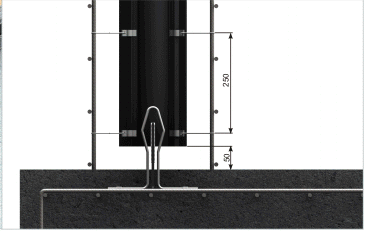 |
| Step 3. Embedding pipes on the sealing band and mounting to reinforcement bars. | |
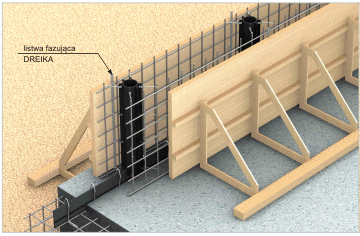 |
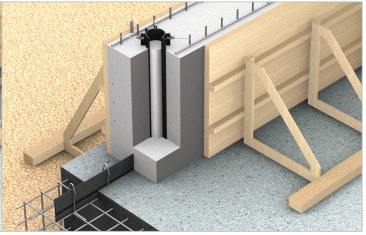 |
| Step 4. Embedding edge beams and arranging the formwork. | Step 5. Wall concreting. |
Concreting phases
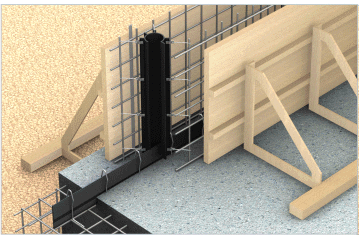 |
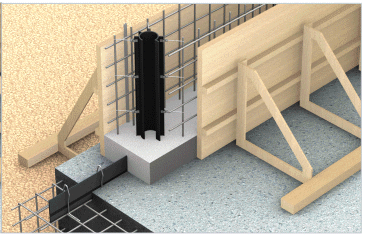 |
| Step 1. Wall formwork set-up. | Step 2. Concreting of the lower part of the entire wall. |
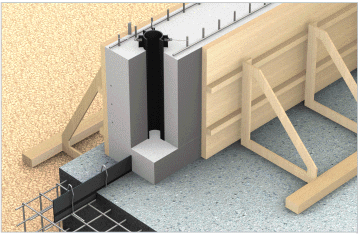 |
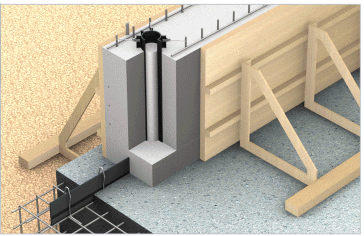 |
| Step 3. Concreting the wall to its designated height. | Step 4. Concreting of the controlled induced crack pipe interior. |

